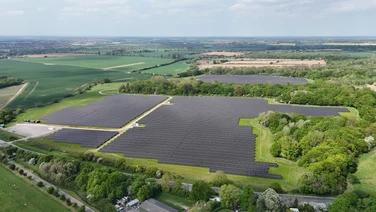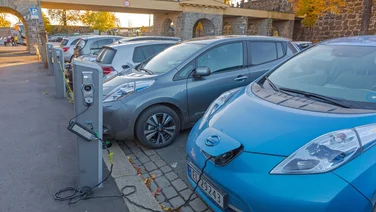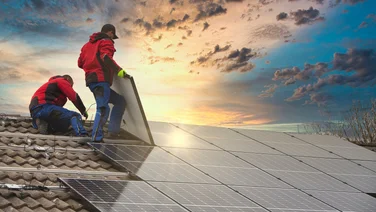We receive a small fee from trusted installers when you request a quote through our site. This helps us keep our content independent, well-researched and up to date – Learn more
- Tumble dryers are the most energy-intensive household appliance
- Microwaves and air fryers consume less energy than ovens and hobs
- It’s worth splashing out on a more energy-efficient model, if you can.
Despite coming down since 2022, the price of energy in the UK is undoubtedly higher than it needs to be, which makes paying the cost for solar panels all the more sensible because they can cut down on bills and your reliance on the gird.
However, even with government grants for solar panels, not everyone can get them. However, fear not, because there are loads of ways for people to still cut their electricity usage and bills, mainly by being aware of the appliances that use the most.

Which home appliances use the most electricity?
A handful of appliances consume a lot more electricity than other household products – we’ve listed the top offenders in the table below.
| Appliance | Electricity usage per year | Estimated annual cost* |
|---|---|---|
| Tumble dryer (4.5 kWh per cycle/four cycles a week) | 936 kWh | £246.64 |
Electric oven (1.2 kWh per use/four uses a week) | 1,456 kWh | £383.66 |
Washing machine (1.2 kWh per use/four washes a week) | 249.6 kWh | £65.77 |
Dishwasher (2.4 kWh per use/five washes a week) | 624 kWh | £164.42 |
Electric hob (1.5 kWh per hour/seven hours a week) | 546 kWh | £143.87 |
Electric shower (5 kW per hour/10 minutes every day) | 303.33 kWh | £79.93 |
275 kWh | £72.46 |
*These prices are based on electricity prices as of November 2025, which are 26.35p per kWh. Consumption data is based on various sources, including Ofgem and Power NI.
**An F-rated fridge-freezer was formerly an A+ rated one before the official ranking system changed in 2021
A lot of people can’t live without some of these appliances, as they’re products that we rely on for a healthy lifestyle. And with the government introducing an 80% gas boiler phaseout by 2035, even more people will be using electricity to power these everyday appliances.
Top tips for cutting down your electricity use at home
If looking at the amount of electricity these household appliances get through is making you feel anxious, don’t worry – there are ways you can soften the blow on your bills.
Obviously, if you can cut back on any of these products – even if it’s just one less clothes wash a week – you should definitely give it a shot. However, a lot of people are already cutting back on the amount of energy they use at home, with no scope to make any more sacrifices.
Alternatively, you can try and find smarter ways to use these appliances. We’ve outlined a few tricks below on how you can make the most energy-consuming appliances less of a burden on your wallet.

Get free solar panel quotes
Answer a few quick questions, and our trusted installers will send you bespoke solar panel quotes – for free.
Tumble dryer
- Keep the lint and evaporator filters clean – Blocked filters make the motor work harder and increase energy consumption
- Keep your dryer in a well-ventilated room – This can prevent overheating, which often means the machine will have to work harder
- Don’t overload the drum – Not only can this damage the tumble dryer, but it can also take the clothes longer to dry, as there won’t be enough room for the clothes to air out
- Don’t underload the drum – Remember, the fewer loads you do each week, the more energy you’ll save
- If possible, use sensor-drying programmes – This setting stops the drying cycle when the clothes have dried. However, it’s not available in all tumble dryers
- Use dryer balls – These work by soaking up excess water and improving airflow, which shortens the amount of time the clothes take to dry
Electric oven
- Don’t open the oven door while cooking – This means you’ll avoid losing heat in the oven
- Turn off the oven five minutes before you’re finished – The oven will continue cooking the food, even when it’s gradually cooling down
- Cook food in smaller pieces – Food baked in smaller portions can cook much faster
- Give it some TLC – Make sure to keep your oven clean and up to date with any maintenance, which will keep it ticking along nicely
- Choose your baking containers wisely – Ceramic and glass containers retain temperature very well. However, if you’re cooking for a short period of time, a metal container or tray might work better, as it absorbs heat very quickly
- Switch to more energy-efficient ways to cook – Consider swapping to an air fryer
Washing machine
- Choose a cool setting – Lower temperatures use less energy. In fact, the European Union’s Ecodesign initiative has made a 20-degree option compulsory on new machine models since 2013
- Don’t underfill the drum – Again, the fewer loads you do each week, the more energy you’ll save
- Maintain your machine – Cleaning the machine’s filter every month and doing a monthly hot wash without clothes can prevent clogging. You should also make sure not to overload the drum, as it could damage the washing machine, and makes the machine less efficient
Dishwasher
- Wait until you have a full load – This way, you can reduce the number of cycles you’ll need to do each week
- Maintain your dishwasher – Always use good-quality detergent and keep the inside of your dishwasher clean and free of food scraps. This will limit limescale build-up and clogging, which avoids damages and can also impact the machine’s efficiency
Electric hob
- Boil the water first – It’s more energy-efficient to use the kettle to boil the water before transferring it to a pan on the hob
- Make sure you use the right size hob – You’ll waste energy if you use a large pan on a small hob burner
Electric shower
The most obvious way to reduce energy in the shower is to limit the amount of time you’re in there, but that’s not always an option for everyone.
You can also decrease the amount of energy your electric shower gets through by investing in an efficient shower head. There are two that you can go for:
- Non-aerating shower heads – These work by forcing the water through smaller holes to produce a high-pressure flow
- Aerating shower heads – These work by restricting the flow of water and mixing it with air. This makes the water appear to flow at the same volume as a normal shower head and results in a more gentle showering experience
Fridge freezer
- Keep the door shut as much as possible – After you let all that hot air into your fridge, it’ll have to work much harder to get back to the optimal temperature
- Check the door seals are working – You don’t want any warm air seeping into your fridge. One way to test this is by holding some paper where the door shuts, and then shutting it. If the paper starts falling, you need to fix the seal on your fridge doors
- Keep it clean – About once a year, you should turn off the fridge and then vacuum/brush away any dust around the coils on the back of the fridge
- Adjust the settings – Fridge freezers don’t need to be set at the coldest setting. The ideal temperature for freezers is -15°C to -18°C, whereas for fridges that’s 3°C to 4°C
- Make sure it’s in the right location – Try to make sure that the coils at the back are at least three inches from a wall, which will help keep it well ventilated. You also want to avoid keeping your fridge away from any appliances that generate heat

Get £7500 towards your heat pump installation through a trusted installer
An MCS-certified heat pump installer can apply for the Boiler Upgrade Scheme on your behalf, get a quote from one now
What else can I do to save energy at home?
Beyond the points mentioned above, there are quite a few other things you could consider if you are looking to save energy costs at home.
Buy energy-efficient products
- Replace appliances with energy-efficient models when they reach the end of their life.
- Higher upfront cost, but they typically last longer and use less electricity.
Use appliances during off-peak times
- Off-peak electricity is cheaper due to lower demand.
- Typical hours: 11 pm–8 am (varies by supplier).
- Run energy-intensive appliances (washing machine, dishwasher) during these times.
Use an air fryer instead of an oven
- Air fryers use 84% less electricity than ovens.
- Regular use can save around £50 a year.
Buy a smart plug
- Lets you monitor and control plugged-in devices via WiFi and your phone.
- Potential savings of around £60 a year, depending on usage.
Draught-proof your home
- Draught-proofing windows and doors can save about £40 a year.
- Draught-proofing a chimney can save around £55.
- Simple fixes include adhesive strips, door snakes, or sealing gaps.
- Up to one-fifth of heating can be lost to draughty windows.
Switch to LED lightbulbs
- Lighting makes up ~15% of the average electricity bill.
- Replacing a 50W halogen with an LED can save ~£75 over its lifetime.
- Replacing all bulbs in a home can save around £40 a year.
Improve home insulation
- More expensive upfront, but highly effective.
- Loft insulation alone can save up to £200 a year.
Reduce “vampire energy” use
- Avoiding standby waste can save up to £146 a year.
- Turn off devices instead of leaving them on standby (TVs, laptops, cookers, printers).


Get free double glazing quotes
Answer a few quick questions, and our trusted installers will send you bespoke double glazing quotes – for free.
Which home appliances are the most efficient?
Despite people relying on electronics more than ever over the past decade, energy conDespite people relying on electronics more than ever over the past decade, energy consumption has actually reduced. In fact, the UK’s electricity consumption in 2021 fell to its second-lowest level this century.
This is mainly due to the fact that most household-product manufacturers have improved their energy efficiency over time.
This means that, compared to the appliances we listed above, most household items are pretty cheap to run – although they’ll be more expensive now that the price of electricity has increased.
Some of the most efficient household appliances include:
- Microwaves – Cost between £29 and £37 a year.
- Air fryers – Roughly £87 a year
- Kettles – Roughly £72 a year
- TV – Between about £22–£35 a year (depending on size)
- 3W LED light – Roughly 2.74 a year
You can read more about how energy-efficient air fryers are on our page.
How do I get my bills down long-term?
Solar panels can significantly cut your electricity bills by generating free power for decades, and pairing them with a home battery can boost those savings even further. Upfront costs vary, but our solar costs and grants page outlines typical prices and the support available.
Double glazing reduces heat loss, eliminates draughts, and keeps your home warmer with far less energy. Although installation can be expensive, our double glazing costs and funding guides show how the long-term savings add up.
Heat pumps offer highly efficient heating and cooling that can lower your energy usage compared with traditional boilers. They do cost more upfront, but our heat pump costs and grants page explains how government support can make installation much more affordable.
Summary
- Having some home appliances is unavoidable, but they dominate your electricity bill, with tumble dryers, ovens, and dishwashers topping the list.
- Cooking habits have a huge impact on energy use, and switching from ovens and hobs to microwaves or air fryers can cut costs dramatically.
- Choosing energy-efficient models makes a long-term difference, especially for high-use appliances like fridge freezers and washing machines.
- Understanding how much electricity each appliance uses helps you prioritise where to cut back, instead of sacrificing essentials.
- Even small changes in how you use big appliances can trim your bill, from reducing dryer cycles to tweaking oven habits.
- With energy prices still rising, being smart about your appliances is one of the simplest ways to regain control over your home energy costs.









